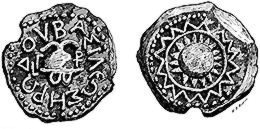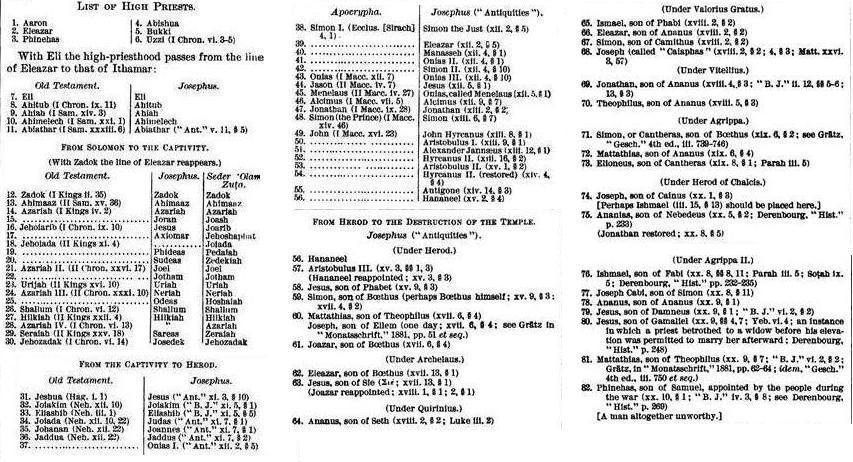|
Jesus, Son Of Fabus
Jesus, son of Fabus, also known as Jesus, son of Phabet, Jesus son of Phiabi or Joshua ben Fabus (), was a Jewish High priest (c. 30 – 23 BCE) in the 1st century BCE. He succeeded Ananelus and was removed by Herod when he appointed his father-in-law, Simon ben Boethus Simon son of Boethus (also known as Simon son of Boëthus, Simeon ben Boethus or Shimon ben Boethus) () was a Jewish High priest (ca. 23 – 4 BCE) in the 1st century BCE and father-in-law of Herod the Great. According to Josephus, he was also ..., to the high-priesthood. References {{Judaism-bio-stub 1st-century BCE High Priests of Israel ... [...More Info...] [...Related Items...] OR: [Wikipedia] [Google] [Baidu] |
Kohen Gadol
High Priest ( he, כהן גדול, translit=Kohen Gadol or ; ) was the title of the chief religious official of Judaism from the early post-Babylonian captivity, Exilic times until Siege of Jerusalem (70 CE), the destruction of the Second Temple in Jerusalem by the Roman Empire, Romans in 70 CE. Previously, in the Yahwism, Israelite religion, including during the time of the History of ancient Israel and Judah, kingdoms of Israel and Judah, other terms were used to designate the leading priests; however, as long as a king was in place, the supreme ecclesiastical authority lay with him. The official introduction of the term "high priest" went hand-in-hand with a greatly enhanced ritual and political significance bestowed upon the chief priest of the Israelites in the post-Exilic period, especially from 411 BCE onward due to the religious transformations brought about during the time of the Babylonian captivity and due to the lack of a List of Jewish states and dynasties, Jewish kin ... [...More Info...] [...Related Items...] OR: [Wikipedia] [Google] [Baidu] |
Ananelus
Ananelus (also known as Hanameel) was a Jewish High priest in the 1st century BCE. Though of priestly descent, he was not a member of the Hasmonean dynasty. The Mishnah (Parah 3:5) identifies him as Hanameel the Egyptian, while Josephus ("Ant." xv. 2, § 4) identifies him as being from Babylon. He was appointed by Herod to fill the office of high priest made vacant by the death of Antigonus (37 BCE). Ananelus's incumbency was of short duration. Prudence compelled Herod to remove him, and to fill his place with the Hasmonean Aristobulus (36 BCE). The youthful Hasmonean, however, was too popular with the patriotic party; though he was a brother of Mariamne, Herod's beloved wife, he was treacherously drowned at Herod's instigation (35 BCE), and Ananelus was restored to the high position. How long he continued in office historians do not state; but it could not have been for many years, since after the execution of Mariamne (29 BCE) Herod remarried, and appointed his second father-i ... [...More Info...] [...Related Items...] OR: [Wikipedia] [Google] [Baidu] |
Herod The Great
Herod I (; ; grc-gre, ; c. 72 – 4 or 1 BCE), also known as Herod the Great, was a Roman Jewish client king of Judea, referred to as the Herodian kingdom. He is known for his colossal building projects throughout Judea, including his renovation of the Second Temple in Jerusalem and the expansion of the Temple Mount towards its north, the enclosure around the Cave of the Patriarchs in Hebron, the construction of the port at Caesarea Maritima, the fortress at Masada, and Herodium. Vital details of his life are recorded in the works of the 1st century CE Roman–Jewish historian Josephus. Herod also appears in the Christian Gospel of Matthew as the ruler of Judea who orders the Massacre of the Innocents at the time of the birth of Jesus, although most Herod biographers do not believe that this event occurred. Despite his successes, including singlehandedly forging a new aristocracy from practically nothing, he has still been criticised by various historians. His reign pola ... [...More Info...] [...Related Items...] OR: [Wikipedia] [Google] [Baidu] |
Simon Ben Boethus
Simon son of Boethus (also known as Simon son of Boëthus, Simeon ben Boethus or Shimon ben Boethus) () was a Jewish High priest (ca. 23 – 4 BCE) in the 1st century BCE and father-in-law of Herod the Great. According to Josephus, he was also known by the name Cantheras (). His family is believed to have been connected to the school of the Boethusians, and a family whose origins are from Alexandria in Egypt. He succeeded Jesus, son of Fabus and was removed by Herod when his daughter, Mariamne II was implicated in the plot of Antipater against her husband in 4 BCE. As a result, Herod divorced her and removed her father (Simon Boethus) as high priest.Josephus, ''Antiquities of the Jews''Book XVII Chapter 4:2 Simon's grandson Herod II was removed from the line of succession in Herod's last will. See also * Simon son of Joseph Simon of Peraea or Simon son of Joseph was a former slave of Herod the Great who rebelled and was killed by the Romans some time after Herod's death in ... [...More Info...] [...Related Items...] OR: [Wikipedia] [Google] [Baidu] |
List Of High Priests Of Israel
This article gives a list of the High Priests (''Kohen Gadol'') of Ancient Israel up to the destruction of the Second Temple in 70 AD. Because of a lack of historical data, this list is incomplete and there may be gaps. High Priests of Israel The High Priests, like all Levitical priests, belonged to the Aaronic line. The Bible mentions the majority of high priests before the Babylonian captivity, but does not give a complete list of office holders. Lists would be based on various historical sources. In several periods of gentile rule, high priests were appointed and removed by kings. Still, most high priests came from the Aaronic line. One exception is Menelaus, who may not have been from the Tribe of Levi at all, but from the Tribe of Benjamin. From the Exodus to Solomon's Temple The following section is based on information found in the various books of the Bible, including the genealogies given in First Book of Chronicles and the Book of Ezra, the works of Josephus and ... [...More Info...] [...Related Items...] OR: [Wikipedia] [Google] [Baidu] |
Simon Son Of Boethus
Simon son of Boethus (also known as Simon son of Boëthus, Simeon ben Boethus or Shimon ben Boethus) () was a Jewish High priest (ca. 23 – 4 BCE) in the 1st century BCE and father-in-law of Herod the Great. According to Josephus, he was also known by the name Cantheras (). His family is believed to have been connected to the school of the Boethusians, and a family whose origins are from Alexandria in Egypt. He succeeded Jesus, son of Fabus and was removed by Herod when his daughter, Mariamne II was implicated in the plot of Antipater against her husband in 4 BCE. As a result, Herod divorced her and removed her father (Simon Boethus) as high priest.Josephus, ''Antiquities of the Jews''Book XVII Chapter 4:2 Simon's grandson Herod II was removed from the line of succession in Herod's last will. See also * Simon son of Joseph Simon of Peraea or Simon son of Joseph was a former slave of Herod the Great who rebelled and was killed by the Romans some time after Herod's death in ... [...More Info...] [...Related Items...] OR: [Wikipedia] [Google] [Baidu] |


